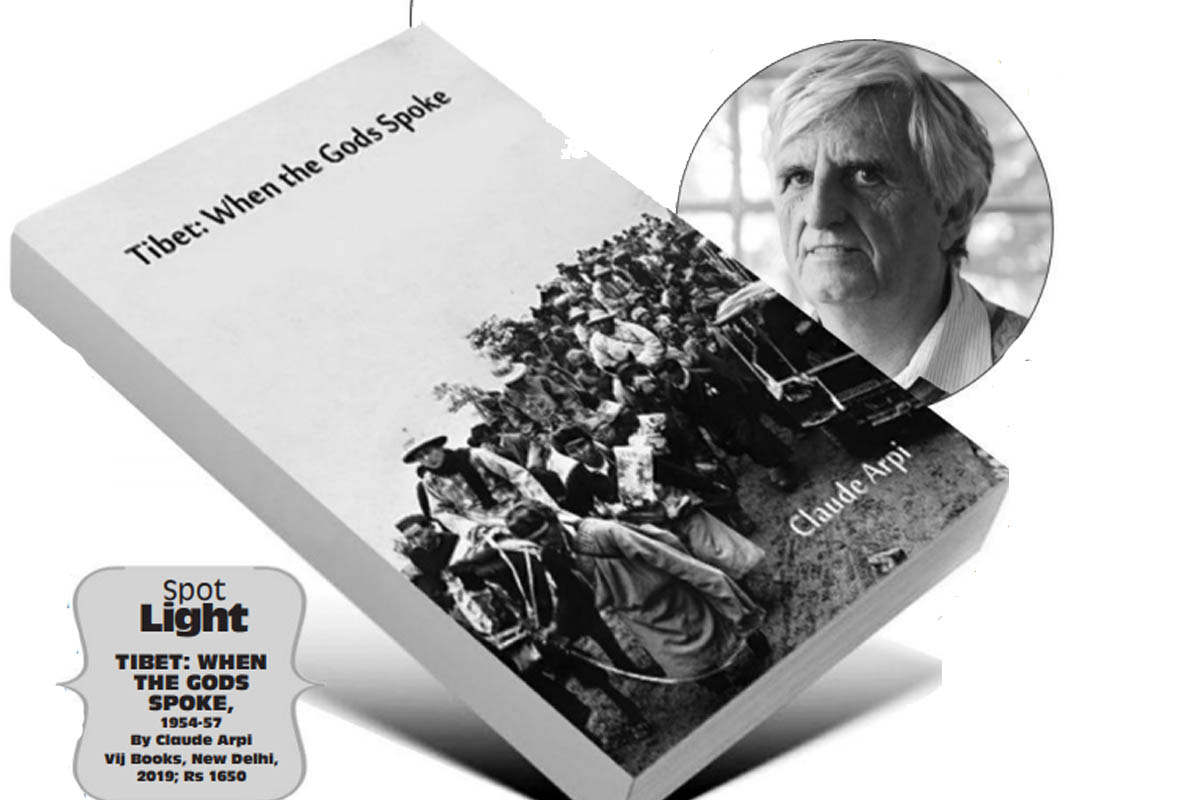The third of four volumes of Claude Arpi’s definitive compilation reveals the extent of India’s loss and Tibet’s loss of autonomy, in India’s foolish trust in the China of Mao and Zhou Enlai. The narrative starts with Zhou’s visit to Delhi in 1954 and ends with the return of the Dalai Lama to Tibet after the Buddha Jubilee in 1957, a tale of lost opportunities due to Nehru’s false assessments. China consolidated its hold on Tibet after the India-China Agreement of 1954 and incursions started the first at Barahoti in 1954 itself, then Shipkila in HP in 1956 and Spiti in Punjab. A flurry of diplomatic notes began between India and China that continued until the Chinese invasion.
India was complicit in this, since the Chinese never adduced any evidence for their claims; they just said they did not agree. India claimed the 1954 Agreement could not have been concluded unless both governments had precise knowledge of their common boundary. India thought that by the Agreement identifying six passes in the middle sector for trade and pilgrims, they had delineated the entire mutually accepted border; the reality was quite otherwise, and China as successor authority in Tibet, had claims in all sectors. The Chinese were in no hurry; these were “not ripe for settlement.”
Advertisement
In 1957 China reported the opening of the road across Aksai Chin, about which the Indian people were told in 1959, the same year as the Chinese incursion in Longju in the North-east. But as early as 1955 the Indian army knew the Chinese were building a road from Tibet to Xinjiang across Askai Chin. It is unbelievable that Nehru was not informed.
Following Barahoti, other incursions such as Nilang south of the watershed, took place. Historian RC Majumdar has written: “It is characteristic of China that if a region once acknowledged her nominal suzerainty even for a short period she should regard it as a part of her empire forever and would automatically revive her claim over it even after a thousand years whenever there was a chance of enforcing it.” But Indian diplomat TN Kaul, echoing Nehru, tried to see some western hand in sponsoring friction between China and India, which tallied with China’s propaganda in Tibet about Americans and warmongers. India compounded its weakness by a piecemeal approach to the incursions, rather than taking the overall view.
Nehru believed India had only given up in Tibet what we could not hold and what had already gone, against what was secured, a friendly and accepted frontier. Any policy to oppose China in Tibet would raise false hopes among Tibetans and lead to greater trauma for them. He urged dissidents to his policies such various Consuls in Lhasa and Political Officers in Gangtok, to have an objective understanding devoid of emotion. He told officials that the border should be regarded as definite, not open for discussion with anybody. As Arpi remarks sarcastically, “it was part of the colonial heritage India could not get rid of fast enough” ~ which included the 12 rest houses and escorts for Indian diplomatic couriers and officials. India-Tibet trade dwindled with communications improvements between China and Tibet, and the revolt of ordinary Tibetans distinguished them from aristocrats and clergy who by and large accepted the Chinese invasion.
Chinese maps showing parts of India as Chinese came to Delhi’s notice. In 1954 Nehru instructed Indian maps not to show any undemarcated areas, but a continuous border. Two years later he told the External Affairs Ministry that it was not desirable to raise the Chinese maps in Parliament. Arpi says, “the entire machinery …from South Block to Bomdila was living in an imaginary world as regards Chinese intentions.” During Zhou’s 1954 visit the border was not raised by India nor during Nehru’s China visit. Nehru told Zhou that India was not concerned about old maps because the boundary was quite clear; the discussion instead centred on Nehru conveying Burma’s concern about Chinese maps. During this visit Nehru met the Dali Lama for the first time. It was not a success. The Dalai Lama records: “he just stands in front of me, without speech, without moving, motionless he remained like that…I said through the Chinese interpreter I am very happy to meet you. He did not give a particular response…”
In Tibet there was no national identity or sense of a nation to be defended. The Dalai Lama was deluded into thinking the Chinese would remain in Tibet only as long as Tibetans wanted them. There had been bad government, unjust taxes, nepotism and social snobbery, but most Tibetans hoped these could be remedied without paying a price to the Chinese. As for India, Tibetans could well ask whether they were not friends of India, and perhaps closer friends than the Chinese.
Prior to independence, India’s northwest and north-east borders were hardly known. In Bhutan, the borders were not demarcated. An Indian surveyor followed the watershed principle and determined the Sikkim-Tibet-Bhutan trijunction at Batangla, the bone of contention between China and India in 2017.
The Chinese speeded up infrastructure ~ roads, schools, hospitals. The first plane landed in 1955 and the first train to Lhasa was in 2006. By 1956 airfields were being constructed, and a plane flew over Lhasa. In 1956 came the Tibet uprising in the east, land reforms were delayed and the two leading lamas were allowed to visit India in 1956- 7. Nehru dismissed the uprising as rumour and disbelieved the Sikkim prince who told Nehru in 1955 that the Dalai Lama was unhappy before and after his trip to China, and the Panchen Lama was unpopular for being a China stooge.
The Panchen Lama curiously seems never to have been contacted by the Consul General in Lhasa. The only picture emerges from his pilgrimage to India in 1956/7. An official recorded that the Panchen Lama was a stooge of the Chinese even in 1923, and had fled from Shigatse to China due to differences with the Dalai Lama, so there were historical precedents. November 1956 was the 2500 anniversary of Buddha’s birth and the two lamas were visiting a foreign country for the first time. Arpi quotes from the reports of Pant with the Dalai Lama, Luthra with the Panchen Lama, and Menon the outgoing Consul General. The Panchen Lama was born and raised in China. Luthra thought he was reconciled to China because they restored him to Tashilunpo monastery in Shigatse. He asserted his right to be equal with the Dalai Lama, though he conceded priority to the Dalai Lama. He felt resigned to the Chinese but thought it was possible to be independent in religion and culture. He thought the rivalry between Lhasa and Shitgatse was against the interests of both, but the Dalai Lama was under malign influences; Lhasa officials thought it below their dignity to approach Shigatse officials and the Dalai Lama’s party would be happy to see the Panchen Lama humiliated. It was easy for the Chinese to sow divisions. Since Nehru gave precedence to the Dalai Lama, the Panchen Lama never got a chance to clarify he was no stooge. The Dalai Lama and Panchen Lama never discussed anything serious; this being left to their retinues.
According to Menon, Tibetan officials were deeply divided between themselves, and confused the Dalai Lama. Zhou Enlai visited Delhi thrice in quick succession, in 1956/7, to counter any support India might give to the lamas and ensure they returned to Tibet. Nehru was in a needless, nervous and desperate hurry to stabilise Indo-China relations, thinking the Dalai Lama hankered for Tibetan independence and looked to India for guidance. He believed Zhou that only a small minority under foreign influence wanted an independent Tibet free from China. Nehru impatiently told the Dalai Lama, “you must realise that India cannot support you.” The Dalai Lama explained that “every time I thought I had reached an understanding with the Chinese, they broke my trust.” When the Dalai Lama met Zhou the latter was full of “charm, smiles and deceit.” He did not believe Zhou “but it was useless to argue.”
Zhou gave Nehru the impression that China accepted the McMahon Line – “it is unfair to us, still we feel that there is no better way than to recognise this Line… we should try to persuade and convince Tibetans to accept it.” Zhou also said that India and Tibet could have direct religious relations – which never happened, perhaps due to Nehru’s hesitation to do anything behind China’s back.
China claimed Bhutan as a vassal in 1910 and Tibet repeated this in 1948. A consequence of China’s invasion of Tibet and incursions of India was that Sikkim and Bhutan felt their future lay with India than with China despite the pull of religion and culture with Tibet. There are excellent maps though more would be useful since some place names could not be identified, and some photos, though the Index is less than satisfactory. The numerous footnotes are very detailed and enormously informative.
The reviewer is Indias former Foreign Secretary
















